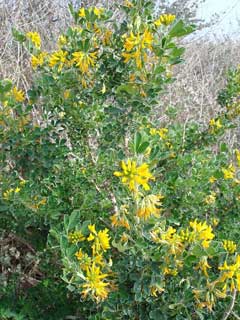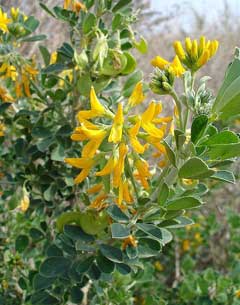 |
|
http://commons.wikimedia.org/wiki/User:Jeantosti |
 |
| http://commons.wikimedia.org/wiki/User:Jeantosti |
Translate this page:
Summary
Physical Characteristics

 Medicago_arborea is an evergreen Shrub growing to 2 m (6ft) by 2 m (6ft).
Medicago_arborea is an evergreen Shrub growing to 2 m (6ft) by 2 m (6ft).
See above for USDA hardiness. It is hardy to UK zone 8 and is frost tender. It is in leaf all year, in flower from May to October. The species is hermaphrodite (has both male and female organs).
It can fix Nitrogen.
Suitable for: light (sandy), medium (loamy) and heavy (clay) soils. Suitable pH: mildly acid, neutral and basic (mildly alkaline) soils. It cannot grow in the shade. It prefers dry or moist soil. The plant can tolerate maritime exposure.
UK Hardiness Map
US Hardiness Map
Synonyms
Plant Habitats
Edible Uses
Leaves - raw or cooked[K]. This plant was supplied to Plants for a Future in early 1994 from a person in Greece who said that it was often used in salads there[K]. Young shoots, when the plant is growing vigorously, have a slightly sweet, grass-like flavour but a rather chewy texture[K]. Older leaves, and younger leaves if the plant is not growing vigorously, have a distinct bitterness and are rather unpleasant[K].
References More on Edible Uses
Medicinal Uses
Plants For A Future can not take any responsibility for any adverse effects from the use of plants. Always seek advice from a professional before using a plant medicinally.
None known
References More on Medicinal Uses
The Bookshop: Edible Plant Books
Our Latest books on Perennial Plants For Food Forests and Permaculture Gardens in paperback or digital formats.

Edible Tropical Plants
Food Forest Plants for Hotter Conditions: 250+ Plants For Tropical Food Forests & Permaculture Gardens.
More

Edible Temperate Plants
Plants for Your Food Forest: 500 Plants for Temperate Food Forests & Permaculture Gardens.
More

More Books
PFAF have eight books available in paperback and digital formats. Browse the shop for more information.
Shop Now
Other Uses
References More on Other Uses
Cultivation details
Requires a warm position in full sun, succeeding in dry or well-drained moist soils[182]. Best grown against a wall[182] in the colder areas of the country[188]. Tolerant of wind and salt spray[200], it grows well in maritime gardens[184]. Plants are not hardy in the colder areas of Britain, they tolerate temperatures down to about -10°c when fully dormant[184, 200], though the young growth in spring can be damaged by late frosts. They do not succeed in the open at Kew, though they grow well against a wall[11]. The flowers have a vanilla or sweet pea scent[245]. Any pruning should consist of cutting out dead wood in the spring[188]. This species has a symbiotic relationship with certain soil bacteria, these bacteria form nodules on the roots and fix atmospheric nitrogen. Some of this nitrogen is utilized by the growing plant but some can also be used by other plants growing nearby[200].
References Carbon Farming Information and Carbon Sequestration Information
Temperature Converter
Type a value in the Celsius field to convert the value to Fahrenheit:
Fahrenheit:
The PFAF Bookshop
Plants For A Future have a number of books available in paperback and digital form. Book titles include Edible Plants, Edible Perennials, Edible Trees,Edible Shrubs, Woodland Gardening, and Temperate Food Forest Plants. Our new book is Food Forest Plants For Hotter Conditions (Tropical and Sub-Tropical).
Shop Now
Plant Propagation
Pre-soak the seed for 12 hours in warm water and then sow in spring in a greenhouse[200]. The seed can also be sown in a greenhouse in autumn. Germination should be quite rapid. Prick out the seedlings into individual pots when they are large enough to handle and grow them on for at least the first winter in a greenhouse. Plant out in late spring or early summer. Cuttings of half-ripe wood, July/August in a frame[188]. Very easy if bottom heat is given[11].
Other Names
If available other names are mentioned here
Native Range
TEMPERATE ASIA: Turkey EUROPE: Albania, Greece (Aegean Islands), Greece (incl. Crete) (Aegean Islands), Italy, Spain
Weed Potential
Right plant wrong place. We are currently updating this section.
Please note that a plant may be invasive in one area but may not in your area so it's worth checking.
Conservation Status
IUCN Red List of Threatened Plants Status :

Growth: S = slow M = medium F = fast. Soil: L = light (sandy) M = medium H = heavy (clay). pH: A = acid N = neutral B = basic (alkaline). Shade: F = full shade S = semi-shade N = no shade. Moisture: D = dry M = Moist We = wet Wa = water.
Now available:
Food Forest Plants for Mediterranean Conditions
350+ Perennial Plants For Mediterranean and Drier Food Forests and Permaculture Gardens.
[Paperback and eBook]
This is the third in Plants For A Future's series of plant guides for food forests tailored to
specific climate zones. Following volumes on temperate and tropical ecosystems, this book focuses
on species suited to Mediterranean conditions—regions with hot, dry summers and cool, wet winters,
often facing the added challenge of climate change.
Read More
Expert comment
Author
L.
Botanical References
11200
Links / References
For a list of references used on this page please go here
Readers comment